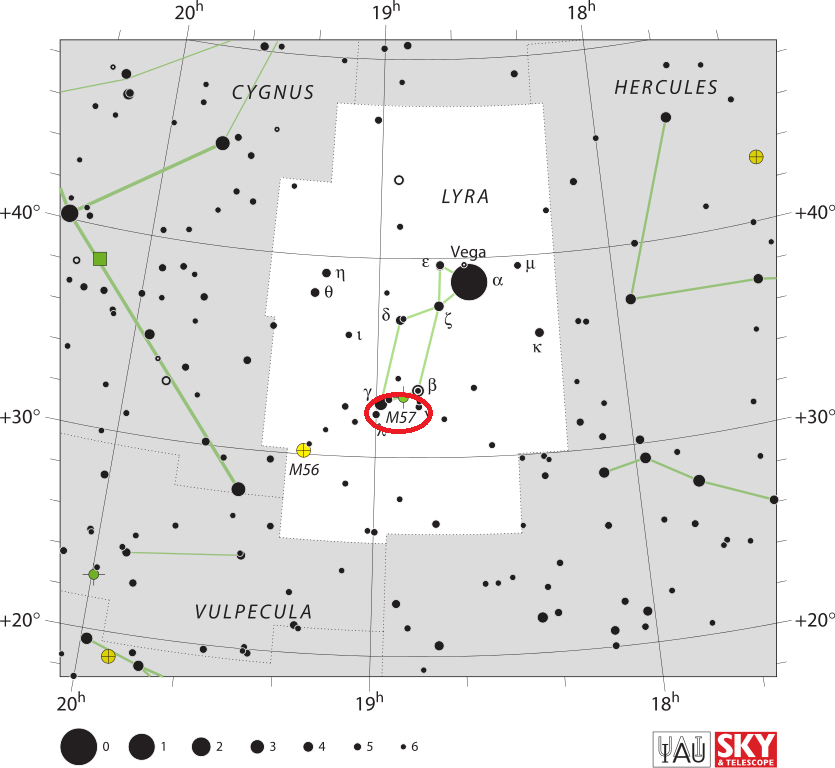Messier 57 (M57), also known as the Ring Nebula, is a well-known planetary nebula located in the northern constellation Lyra. The Ring Nebula has an apparent magnitude of 8.8 and lies at an approximate distance of 2,300 light years from Earth. It has the designation NGC 6720 in the New General Catalogue.
Messier 57 lies south of Vega, the brightest star in Lyra and one of the stars that form the Summer Triangle, a prominent asterism found overhead in the summer sky. The nebula is easy to find as it is located roughly 40 percent of the distance from Sheliak, Beta Lyrae, to Sulafat, Gamma Lyrae.
The nebula cannot be resolved in small binoculars and is best seen in 8-inch and larger telescopes. Even smaller telescopes will reveal the nebula’s ring shape, while medium-sized instruments will also show its interior hole.
With a visual magnitude of 14.8, the nebula’s central white dwarf is a difficult target. The best time of year to observe M57 is in the summer months.
Messier 57 occupies an area of 1.5 by 1 arc minutes. It is classified as a bipolar nebula as it has thick equatorial rings that extend its structure through its main axis of symmetry, which is seen at about 30° from Earth.
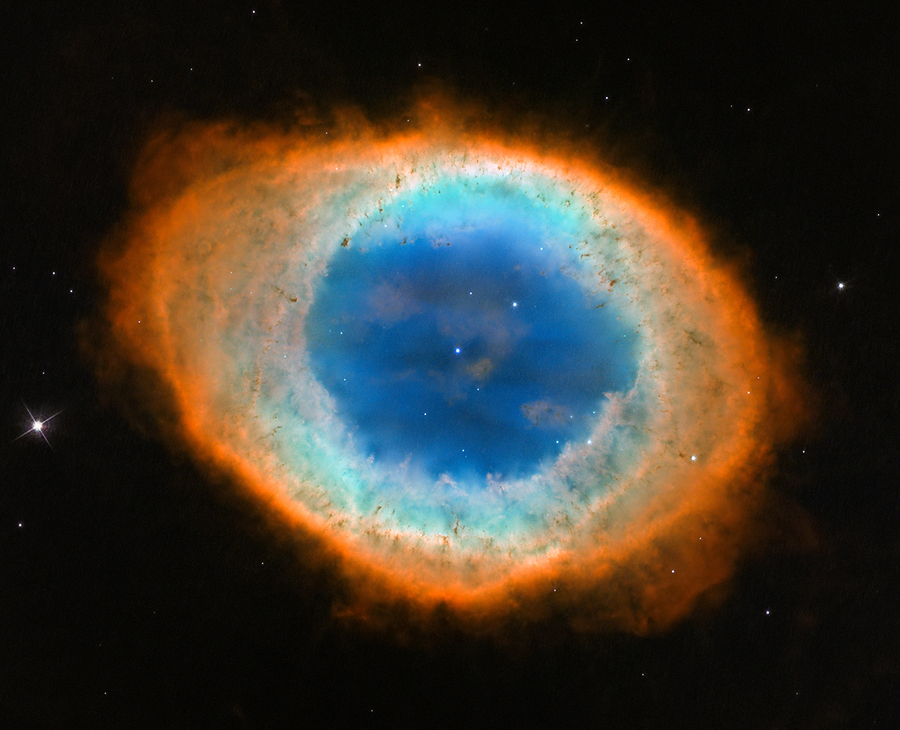
The Ring Nebula is one of only four planetary nebulae listed in Messier’s catalogue, along with the Dumbbell Nebula (M27), the Little Dumbbell Nebula (M76), and the Owl Nebula (M97).
Planetary nebulae are formed when a dying red giant star expels its shell of ionized gas to form the nebula, while the star itself becomes a white dwarf, a dense stellar remnant roughly the size of the Earth. The central star of the Ring Nebula ejected its outer layers 6,000 to 8,000 years ago and they have since expanded over an area about 1.3 light years in radius. The nebula is expanding at a rate of about 1 arc second per century, which corresponds to a velocity of 20 to 30 km/s.
The nebula’s ring shape appears in different colours and the different layers seen in images are not equally bright. This is because they consist of different layers of the central star, or different elements at different temperatures. The outermost layer, which appears red in images, consists almost entirely of hydrogen. Elements that appear in different colours include doubly-ionized oxygen, molecular nitrogen, molecular sulphur, and helium.
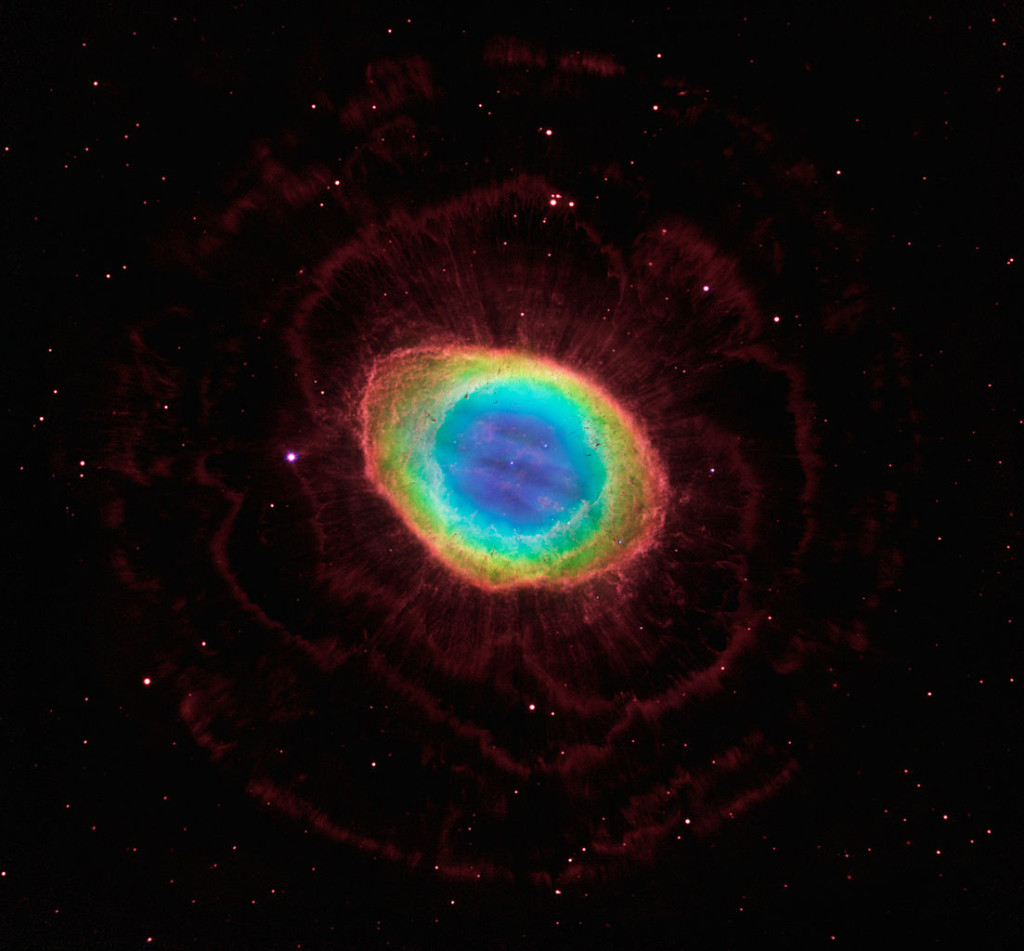
The central planetary nebula nucleus (PNN) has an estimated mass of 0.61 to 0.62 solar masses and a surface temperature of about 125,000 K. It is about 200 times more luminous than the Sun.
The Ring Nebula was discovered by the French astronomer Antoine Darquier de Pellepoix in January 1779. He wrote:
This nebula, to my knowledge, has not yet been noticed by any astronomer. One can only see it with a very good telescope, it is not resembling any of those already known; it has the apparent dimension of Jupiter, is perfectly round and sharply limited; its dull glow resembles the dark part of the Moon before the first and after the last quarter. Meanwhile, the center appears a bit less pale than the remaining part of its surface.
Charles Messier discovered the object independently on January 31, 1779. He noted:
A cluster of light between Gamma & Beta Lyrae, discovered when looking for the Comet of 1779, which has passed it very close: it seems that this patch of light, which is round, must be composed of very small stars: with the best telescopes it is impossible to distinguish them; there stays only a suspicion that they are there. M. Messier reported this patch of light on the Chart of the Comet of 1779. M. Darquier, at Toulouse, discovered it when observing the same comet, and he reports: “Nebula between gamma and beta Lyrae; it is very dull, but perfectly outlined; it is as large as Jupiter & resembles a planet which is fading.”
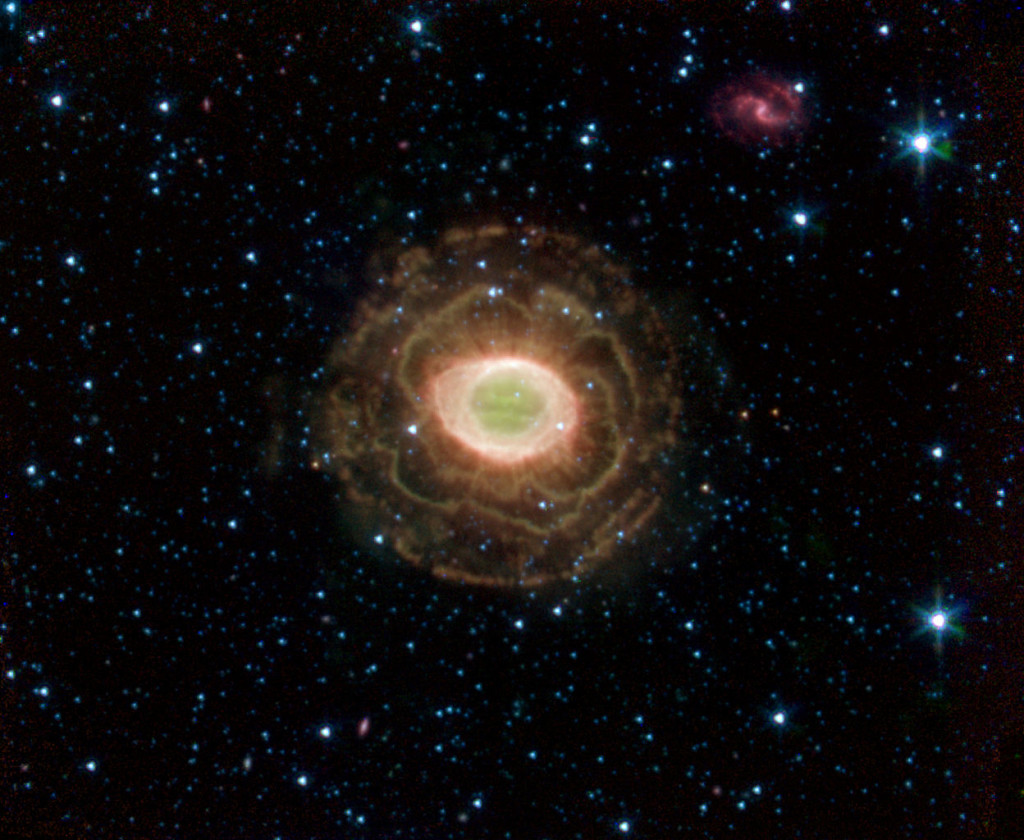
The telescope’s infrared array camera detected this material expelled from the withering star. Previous images of the Ring Nebula taken by visible-light telescopes usually showed just the inner glowing loop of gas around the star. The outer regions are especially prominent in this new image because Spitzer sees the infrared light from hydrogen molecules. The molecules emit infrared light because they have absorbed ultraviolet radiation from the star or have been heated by the wind from the star. Image: NASA/JPL-Caltech/J. Hora (Harvard-Smithsonian CfA)
William Herschel observed the nebula several times in the 1780s and noted:
Among the curiosities of the heavens should be placed a nebula, that has a regular, concentric, dark spot in the middle, and is probably a Ring of stars. It is of an oval shape, the shorter axis being to the longer as about 83 to 100; so that, if the stars form a circle, its inclination to a line drawn from the sun to the center of this nebula must be about 56 degrees. The light is of the resolvable kind [i.e., mottled], and in the northern side three very faint stars may be seen, as also one or two in the southern part. The vertices of the longer axis seem less bright and not so well defined as the rest. There are several small stars very near, but none seems to belong to it. It is the 57th of the Connoissance des Temps [Messier’s catalogue].
In 1800, German astronomer Friedrich von Hahn said he had seen the Ring Nebula’s central star a few years earlier, but could no longer find it. He also noticed changes in the interior of the ring.
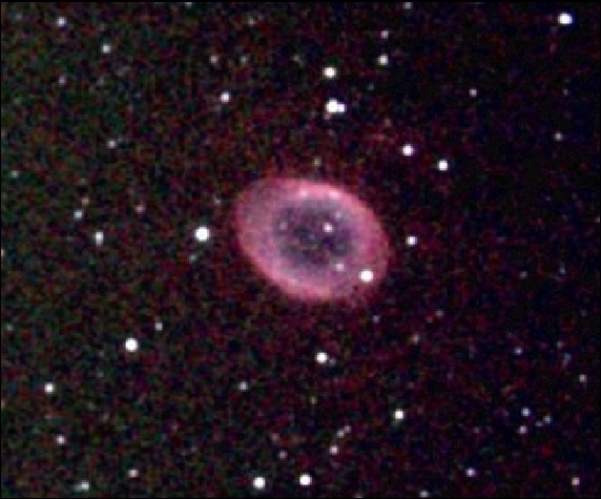
John Herschel catalogued the nebula as h 2023 in 1829 and offered the following description:
Annular nebula between Beta and Gamma Lyrae. Position angle of longer axis of annulus is 57.0 deg by micrometer. The small star following is almost exactly on the parallel of its centre, distance about the same as the breadth of the ring. The central vacuity is not black; a nebulous light fills it. The edges are not sharply cut off, very slightly ill defined.
Herschel later added the nebula to his General Catalogue as GC 4447.
Admiral William Henry Smyth observed the Ring Nebula in July 1835 and provided a more detailed description:
This annular nebula, between Beta and Gamma on the cross-piece of the Lyre, forms the apex of a triangle which it makes with two stars of the 9th magnitude; and its form is that of an elliptic ring, the major axis of which trends sp to nf [SW to NE]. This wonderful object seems to have been noted by Darquier, in 1779; but neither he nor his contemporaries, Messier and Méchain, discerned its real form, seeing in this aureola of glory only “a mass of light in the form of a planetary disc, very dingy in colour.” Sir W. Herschel called it a perforated resolvable nebula, and justly ranked it among the curiosities of the heavens. He considered the vertices of the longer axis less bright and not so well defined as the rest; and he afterwards added, “By the observations of the 20-feet telescope, the profundity of the stars, of which it probably consists, must be of a higher than the 900th order, perhaps 950.” This is a vast view of the ample and inconceivable dimensions of the spaces of the Universe; and if the oft-cited cannon-ball, flying with the uniform velocity of 500 miles an hour, would require millions of years to reach Sirius, what an incomprehensible time it would require to pass so overwhelming an interval as 950 times the distance! And yet, could we arrive there, by all analogy, no boundary would meet the eye, but thousands and ten thousands of other remote and crowded systems would still bewilder the imagination.
In my refractor this nebula has a most singular appearance, the central vacuity being black, so as to countenance the trite remark of its having a hole through it. Under favourable circumstances, when the instrument obeys the smooth motion of the equatoreal clock, it offers the curious phenomenon of a solid ring of light in the profundity of space. The annexed sketch affords a notion of it.
Sir John Herschel, however, with the superior light of his instrument, found that the interior is far from absolutely dark. “It is filled,” he says, “with a feeble but very evident nebulous light, which I do not remember to have been noticed by former observers.” Since Sir John’s observation, the powerful telescope of Lord Rosse has been directed to this subject, and under powers 600, 800, and 1000, it displayed very evident symptoms of resolvability at its minor axis. The fainter nebulous matter which fills it, was found to be irregularly distributed, having several stripes or wisps in it, and the regularity of the outline was broken by appendages branching into space, of which prolongations the brightest was in the direction of the major axis.
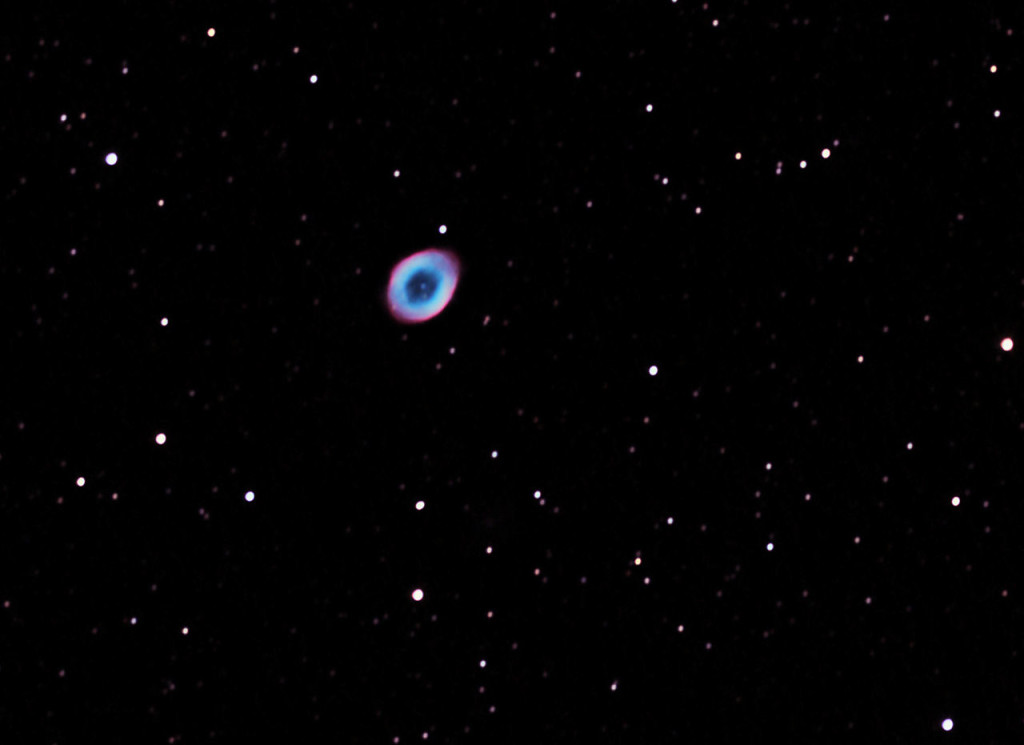
Lord Rosse sketched M57 after observing it with his 3-feet telescope. He noted:
The annular nebula in Lyra; 2 is the star in Sir John Herschel’s sketch; I have inserted the six other stars as in some degree tests of the power of a telescope. Near star 3 there are two very minute stars seen with great difficulty; the others are easily seen whenever the night is sufficiently good to show the nebula well. The filaments proceeding from the edge become more conspicuous under increasing magnifying power within certain limits, which is strikingly characteristic of a cluster; still I do not feel confident that it is resolvable. I am however disposed to think that it was never examined when the instrument was in as good order, and the night as favourable, as on several occasions when the resolvable character of fig. 26 [Messier 27] was ascertained.
In 1864, English astronomer and spectroscopy pioneer William Huggins studied the spectra of several nebulae and found that some of them, including the Ring Nebula, showed spectra similar to those of fluorescing glowing gases. This led Huggins to conclude that planetary nebulae were not composed of unresolvable stars, as Messier and William Herschel had believed, but that they were in fact nebulosities. Huggins wrote:
It is obvious that the nebulae 37 H IV (NGC 3242), Struve 6 (NGC 6572), 73 H IV (NGC 6826), 1 H IV (NGC 7009), 57 M, 18 H. IV (NGC 7662) and 27 M. can no longer be regarded as aggregations of suns after the order to which our own sun and the fixed stars belong. We have with these objects to do no longer with a special modification only of our own type of suns, but find ourselves in the presence of objects possessing a distinct and peculiar plan of structure.
In place of an incandescent solid or liquid body transmitting light of all refrangibilities through an atmosphere which intercepts by absorption a certain number of them, such as our sun appears to be, we must probably regard these objects, or at least their photo-surfaces, as enormous masses of luminous gas or vapour. For it is alone from matter in the gaseous state that light consisting of certain definite refrangibilities only, as is the case with the light of these nebulae, is known to be emitted.
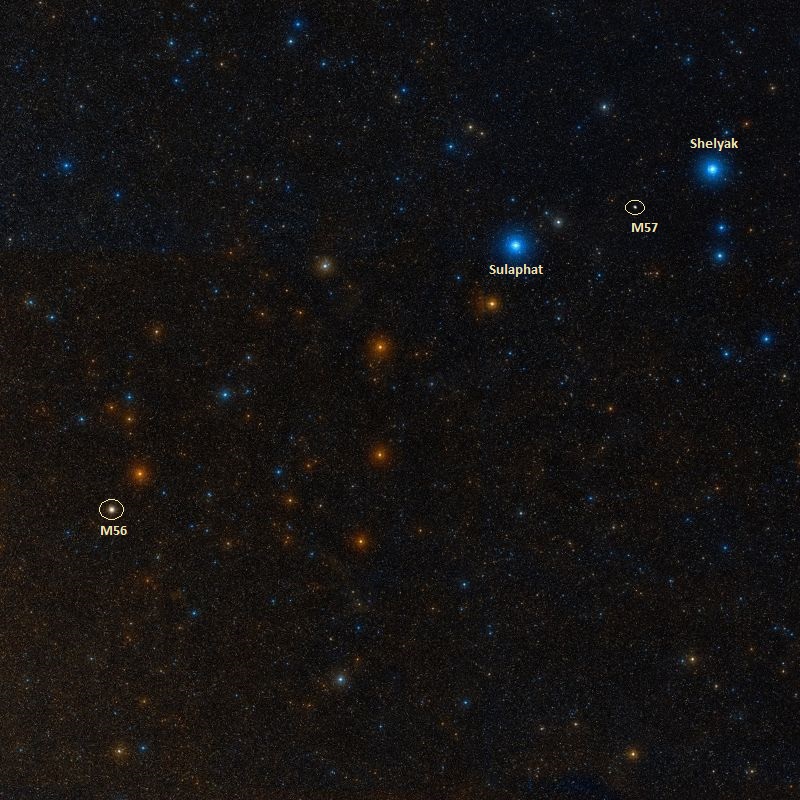
Hungarian astronomer Jenő Gothard was the first to photograph the nebula in 1886. He discovered the central planetary nebula nucleus (PNN) on September 1, 1886 from images taken at his observatory in Herény, Hungary.
In 1935, J.C. Duncan discovered the nebula’s halo. Deep images have revealed that M57 has an extended halo extending to more than 3.5 arc minutes.
FACTS
| Object: Nebula |
| Type: Planetary |
| Designations: Messier 57, M57, NGC 6720, Ring Nebula, PK 063+13 1, GC 4447, BD+32 3246, CSI+32-18517, VV 214, WD 1851+329, GSC2 N0223131306, PN G063.1+13.9 |
| Constellation: Lyra |
| Right ascension: 18h 53m 35.079s |
| Declination: +33°01’45.03” |
| Distance: 2,300 light years (700 parsecs) |
| Age: 6,000 to 8,000 years |
| Apparent magnitude: +8.8 |
| Absolute magnitude: -0.2 |
| Apparent dimensions: 230” x 230” |
| Radius: 1.3 light years |
LOCATION
